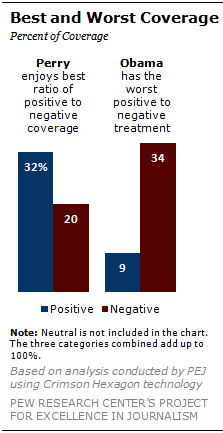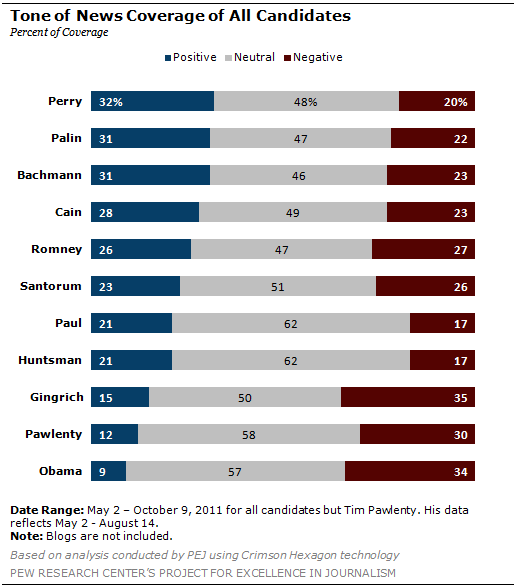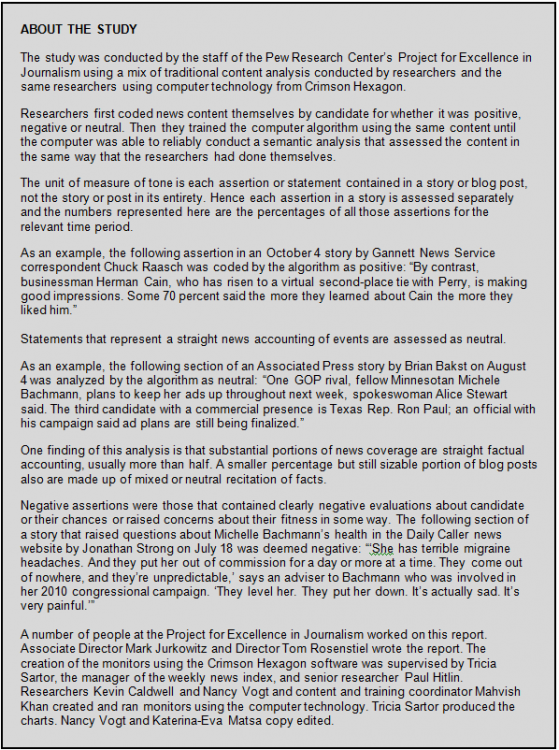How News Media and Blogs Have Eyed the Presidential Contenders during the First Ph ase of the 2012 Race
ase of the 2012 Race
In the first months of the race for president, that weeding out period before citizens ever vote or caucus, Texas Governor Rick Perry has received the most coverage and the most positive coverage from the news media of any GOP contender, according to a new study by the Pew Research Center’s Project for Excellence in Journalism.
But in what is already a fluid race, Perry lost that mantle to Herman Cain two weeks ago, after the Florida straw poll and a faulty debate performance, according to the study, which combines traditional media research methods with computer algorithms to track the level and tone of coverage of candidates for president. The analysis also shows that Cain’s narrative actually started to become more positive in late August, six weeks before he began to rise in the polls.
Meanwhile, former Massachusetts Governor Mitt Romney remains the one constant—portrayed as the ever-present if not passionately embraced alternative in the GOP field. Despite often leading in the polls, Romney has typically received less coverage and less positive coverage than his chief rival of the moment—and that remained true in early October after Perry faltered. Overall, he is second in the amount of attention received and the tone of that narrative has been unwaveringly mixed.
One man running f or president has suffered the most unrelentingly negative treatment of all, the study found: Barack Obama. Though covered largely as president rather than a candidate, negative assessments of Obama have outweighed positive by a ratio of almost 4-1. Those assessments of the president have also been substantially more negative than positive every one of the 23 weeks studied. And in no week during these five months was more than 10% of the coverage about the president positive in tone.
or president has suffered the most unrelentingly negative treatment of all, the study found: Barack Obama. Though covered largely as president rather than a candidate, negative assessments of Obama have outweighed positive by a ratio of almost 4-1. Those assessments of the president have also been substantially more negative than positive every one of the 23 weeks studied. And in no week during these five months was more than 10% of the coverage about the president positive in tone.
These are some of the findings of new work by the Pew Research Center’s Project for Excellence in Journalism that combines PEJ’s ongoing weekly content analysis with computer algorithmic technology developed by Crimson Hexagon. In combination, the two research methods assess coverage across more than 11,500 news media outlets each day. A separate analysis also tracks the level of discussion and tone across hundreds of thousands of blogs. The study covers the 23 weeks from May 2, when candidates began to announce, to October 9, one week ago—that first phase of what might be called The Media Primary.
The blogosphere, it turns out, is proving a much rougher environment than the news media for candidates, including contenders associated with the Tea Party movement. But one candidate has emerged as the winner of the blog primary so far—Texas Congressman Ron Paul.
The research, across such a wide range of outlets, and using a combination of conventional and computer tools, make it possible to quickly compare shifts in news coverage and in blogs with events in the campaign and movements in the polls. The project will continue to provide reports tracking the level and tone of candidate coverage on a weekly basis throughout the campaign season.
Despite his recent stumbles, Rick Perry received the most flattering coverage of any candidate over the five months studied. Positive coverage about his candidacy in the news media outweighed negative 32% to 20% (the remaining assessments were neutral). His coverage began to be less positive the week of September 12-18, before his Florida debate performance. But Perry endured only one week in which coverage was more negative than positive overall, October 3-9. And while he did not enter the race until August, he has received more coverage than any other candidate during the five months studied.
The tone of coverage of Mitt Romney, by contrast, has been mixed—26% positive and 27% negative—numbers that are less positive than those for Perry, Cain, Michele Bachmann or non-candidate Sarah Palin. Yet what stands out most is consistency. While other major candidates have risen and fallen in the amount and tone of coverage received, the basic arc of Romney’s narrative has wavered little from week to week from May to early October.
Overall, news coverage of Herman Cain has been moderately more positive (28%) than negative (23%). But most of that flattering narrative has come recently—the result of eight straight weeks when positive assessments of his candidacy outweighed negative. The first two weeks of October have been particularly positive. From May through July, however, Cain was largely ignored, and his coverage was more negative or mixed.
Minnesota Congresswoman Michele Bachmann’s coverage overall has been substantially more positive (31%) than negative (23%). But she had the wildest ride of any candidate in the race. In five months, she moved in the media narrative from a long shot to a surprise contender, to an object of scrutiny about her health and husband. She re-emerged as the Iowa straw poll winner, and now she is back where she started, an unlikely contender discounted in the narrative. At the same time, she has been largely pummeled in the blogs throughout the time studied.
Former Alaska Governor Sarah Palin continued to display a gift for fascinating the media during these past five months. Though she never entered the race, finally announcing on October 5 that she would not run, Palin seemed to generate significant coverage whenever she hinted she might get into the contest. That was enough to make her the fourth-most-covered Republican figure in news coverage, and the most-discussed candidate in blogs. And despite her complaints about what she calls the “lamestream media,” Palin enjoyed coverage that was considerably more positive than negative—by a factor of almost 3-2. Bloggers, meanwhile, were much more disapproving.

The two biggest losers among the GOP have been former House Speaker Newt Gingrich and former Minnesota Governor Tim Pawlenty, whose candidacy lasted less than three months. While Gingrich generated much more coverage than Pawlenty, both candidates received negative assessments that outweighed positive ones by a ratio of more than 2-1. Both candidates also endured negative coverage virtually every week.
The GOP field also has what might be called the long shot duo. They are former Pennsylvania Senator Rick Santorum and former Utah Governor Jon Huntsman. Their candidacies are distinguished in the media by two elements. They both generated only modest amounts of coverage. And that coverage has been mixed between positive and negative assessments.
The same could be said of the narrative in the news media of Texas Congressman Ron Paul, who received the least coverage of any candidate overall (although from July on, Newt Gingrich received less coverage than Paul did). The difference with Paul is that he has received, by far, the most favorable coverage of any candidate in the blogosphere—48% positive and only 15% negative.
As for Barack Obama, 9% of the news coverage about him over the last five months has registered as positive while 34% has been negative and 57% has been neutral or largely straight news accounting of events. In each of the 23 weeks studied, his negative coverage exceeded his positive coverage by more than 20 percentage points. And in none of those weeks did his negative coverage fall below 30%. The tone of Obama’s coverage on blogs, while still overwhelmingly negative, was slightly better—14% positive and 36% negative.
The study examined four basic elements of each candidate’s narrative. It measured how much attention each candidate received in news media. It also examined the tone of that coverage. Then, separately, it assessed the amount of attention and tone in blogs.
To analyze the level of attention, researchers identified all of the campaign coverage from a core list of mainstream news outlets using PEJ’s weekly analysis, called the News Coverage Index. That core list includes 52 different news outlets from newspapers, cable news, broadcast television, the 12 most popular news websites in the country, and radio news (NPR, syndicated radio headlines and three talk radio personalities).

To assess the tone of coverage, PEJ researchers then employed computer algorithmic software from Crimson Hexagon. Researchers conducted a tone analysis and then “trained” the algorithm to follow the same rules as they had themselves. PEJ also conducted inter-coder tests to ensure the computer coding was replicable and valid by comparing human coding to the results derived by the algorithm. The project also had different people build the algorithms separately to ensure that they were achieving consistent results. Each computer algorithm was then additionally tested for reliability by having multiple researchers review the content assessed and the results.
The tone analysis was conducted on two different samples. The first was of the coverage and commentary on more than 11,500 news outlets, based on their RSS feeds. While the content is text based, the material on various television news sites often closely resembled the stories that had aired on television, and in some cases were exact transcripts. The second was from hundreds of thousands of blogs. (Facebook and Twitter feeds were not included after researchers found that the political assessment offered there was typically quite brief or referred to blog or news content.)
Among other findings:
- While almost all of the Republican candidates fared worse in blogs than they did in the coverage and commentary in news outlets, there were three exceptions. The conversation about Mitt Romney and Herman Cain in the blogosphere was similar in tone to their news coverage. And Ron Paul did markedly better in the blogosphere than in the press.
- In contrast to news coverage, however, the tone of conversation about each candidate in the blogosphere tended to change relatively little over time. In other words, while news coverage might move from more positive to more negative depending on events, we saw no such movement in blogs. Those candidates treated negatively overall in the blogs experienced negative coverage every week and in fairly static percentages. The same was true for those whose coverage overall was positive.
- One question is whether media coverage is a leading indicator that may drive public opinion or is a lagging indicator that follows poll numbers (a description of improving standing in the horse race would be considered positive in the study). The data suggest that the relationship between a candidate’s poll numbers and the tone of his or her coverage, varied widely. Bachmann’s poll numbers, for instance, jumped well before the tone of her coverage improved. The coverage for Cain, in contrast, turned more positive in August, weeks ahead of his rise in the polls. In the case of Romney, his move up in the polls in early June was not accompanied by any particular change in the tone of his media narrative.
- One factor in the broader media narrative is which candidates are vetted by reporters, beyond their public comments each day. While the quantitative aspect of this report cannot answer that, changes in tone and a more subjective look at coverage during those moments of shift offer some hint. The news media appeared to launch an examination of the records and resume of some candidates—notably Michele Bachmann and Rick Perry—after their rise in the polls, while largely sparing other candidates, such as Ron Paul and, so far, Herman Cain.
- Debates, now growing in number, are having an impact on the media narrative, perhaps because the candidates find themselves in less scripted encounters during these events. The study finds that debates have coincided with some notable shifts in tone of coverage. The June 13 CNN debate, for instance, produced some good reviews and a boost in status for Michele Bachmann while furthering doubts about Tim Pawlenty. And some difficult debate performances, most notably on September 22, have injected some critical coverage into what had been very favorable media treatment of Rick Perry.
- There have been four distinct phases to this early media primary. The first one, which generated the first significant amount of campaign coverage, was the Donald Trump phase that began in late April. That was followed by the candidate announcement cycle (mid-May through June) and then the debt doldrums period from early July through the beginning of August, when campaign coverage was completely overshadowed by the debt drama in Washington D.C. The next phase began in mid-August, when Rick Perry entered the race and instantly changed its dynamic.
- Finally, given the breadth of content across the blogosphere, it is impossible to know quantitatively how many of those opinions evaluating a GOP candidate negatively are coming from blogs that tilt liberal and Democratic and those evaluating them positively are coming from conservative and Republican blogs. Given the nature of the blogosphere, conservative primary voters may not read commentary on liberal blogs, and vice versa. Clearly some of the comments critical of candidates, however, are coming from within their own parties. Moreover, some of it is from bloggers evaluating the contenders by the same criteria as the news media—based on their chances for winning.



